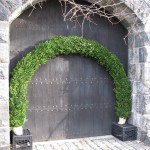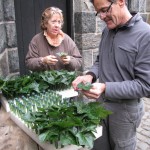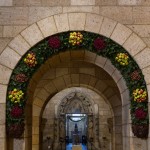Above, from left to right: boxwood-covered form for one of the Main Hall arches; preparing the ivy; a view of the decorated arch above the entry into the Romanesque Hall.
We have been working busily for the last few weeks preparing the holiday decorations that will deck the Museum from the first of December until the fifth of January. The decorations are made from natural materials, and all of the plant stuffs used were associated with the medieval celebration of Christmastide. This great feast embraced the twelve days between the Nativity and the Epiphany, which commemorated the visit of the Three Kings to the infant Jesus.
The wreaths and garlands on display are the work of many hands, and could not be fabricated by the Gardens staff without the help and enthusiasm of volunteers and other staff members who give up their lunch hours and their days off to help gather ivy, secure bay leaves and wheat ears to florist???s picks, and buff apples until they glow.
Because pictorial representations of medieval Christmas decorations are rare, our designs are based on evidence gleaned from carols, wassails, romances, and artworks. The medieval practice of decking churches and halls with greens for the season had its roots in ancient custom. The early Church had banned the use of evergreens because of their ties with pagan winter festivals, such as the Roman Saturnalia. By the Middle Ages, these plants had been given Christian interpretations and were used to celebrate the feast days of the Christian calendar.
The first decorations to be installed are the arches of fruits, nuts, and greenery that adorn four of the doorways in the Main Hall. Wooden forms that fit into the recesses above the arched doorways are wrapped in straw. Branches of boxwood are then inserted into the straw to give volume and provide a green ground for the other elements. Individual leaves of ivy gathered on the Museum grounds are put into florist???s water picks and inserted into the boxwood-covered form, and clusters of lady apples, rosehips, and hazelnuts are set in bosses among the ivy leaves. Lady apples—a very old variety that may well date back to Roman times—are still commonly available as a dessert apple at this time of year. The rosehips allude to the rose symbolism so prominent in medieval Christmas carols.
Both ivy and holly were associated with Christmas in the Middle Ages, but holly does not tolerate the warm, dry air in the Main Hall well. It is used elsewhere in the Museum.
Apples and nuts, stored for winter consumption, were a conspicuous part of the Christmas feast, as they are today. It was also the custom to wassail fruit and nut trees in winter, to encourage them to bear plentiful crops in the coming year. Fruits and nuts were ancient symbols of fertility that came to bear specifically Christian meanings, and they often appear in representations of the Virgin and Child.
More on the plants used to deck The Cloisters and their medieval meanings to come . . .
—Deirdre Larkin




December 3, 2008 at 10:26 pm
I absolutely LOVE the arch decorations!!!! I want them for my house!!!!!!!!!!!! thanks for the ideas!!
December 9, 2008 at 11:25 am
Dear Thea,
The arches are labor-intensive, but I do think that they are worth the trouble—the greens contrast beautifully with the stone and the apples give light and warmth to the Main Hall. We refresh the arches every Monday, when the Museum is closed to the public. All the apples are replaced weekly, but the ivy is very stable and needs only minimal attention. Large-leaved landscape ivy that you’ve picked yourself will hold up much better for you than florist’s ivy, if you do want to try something similar yourself. A single leaf of ivy in a water pick can last several weeks. You can add some floral preservative to the water if you like.
August 6, 2010 at 10:28 pm
This is a good inspiration site. I did a search looking for “ivy arches” and came upon this post. I have a client interested in something similar. Just wanted to say thank you for the ideas.
August 30, 2010 at 6:21 am
Ivy arches are stunningly beautiful, its simplicity is what made it stand out.
September 7, 2010 at 10:36 am
The arch way greenery is great, is there much upkeep with having one, and if so what is required?
September 27, 2010 at 9:27 pm
Although Christians used evergreens in the Middle Ages, it seems that the spruce and noble fir type of greenery used in wreaths and, of course, the Christmas Tree have their origins in Northern Europe and Germany dating back to the 17 and 18 hundreds.
December 29, 2010 at 10:35 am
To J.A. Assoc—
The arches are designed to require only weekly maintenance, which involves replacing the apples, and any ivy leaves that may have withered. However, the intitial labor involved in their construction is very considerable I have never thought these designs would be commercially viable, nor could we afford to have them constructed by a floral design firm. They are labors of love, to which many volunteer as well as staff hours are devoted.
D.